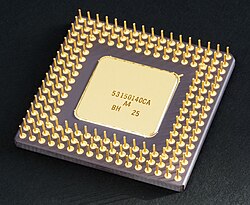Intel DX2
Insert non-formatted text here


The Intel 80486DX2 is a CPU produced by Intel that was introduced in 1992. The 80486DX2 is identical to a 80486DX but for the addition of "clock doubling" technology. It was the first chip to use clock doubling, whereby the processor performs two clock cycles per single cycle of the memory bus. Essentially, the processor's speed is set to double of the speed of the system bus. Because of this, an Intel 80486DX2 is faster than an Intel 80486DX-based system at the same bus speed; a normal DX chip performs one processor clock cycle per system bus cycle, while a DX2 chip performs two processor clock cycles per bus cycle.
Intel produced two 80486DX2 CPUs:
- 50 MHz CPU for systems with a 25 MHz front side bus
- 66 MHz CPU for systems with a 33 MHz front side bus
The Legend of the DX2-66
For most people brought up during the 32-bit era the 80486DX2-66 is a legendary processor. Often coupled with 8 MB or 16 MB of RAM and a VESA Local Bus video card, they were the top tier processor when they were released, a solid mid-range configuration option soon after and a decent performer on a budget at the end of their life cycle. The DX2-66 is often remembered most because of its excellent performance on the generation of games current at its release. Soon after, as more games demanded a 486 processor, the DX2-66 shone as a solid performer overtaking the SX-25 and SX-33 configurations as the system of choice for most computers. During the end of its lifespan, with the introduction of 3D graphics, the DX2-66 started to fall behind. Nevertheless, while Quake's system requirements listed "Pentium" on the box, a DX2-66 could comfortably handle Quake at lower resolutions.
AMD also produced an 8ʈ0 MHz 'DX2' chip for systems with a 40 MHz front side bus.
It is now standard practice for a CPU to perform more than one clock cycle per bus clock cycle.

